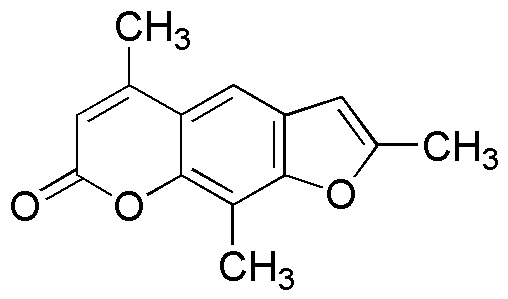Trioxsalen is widely utilized in research focused on:
- Phototherapy for Skin Disorders: This compound is effective in treating psoriasis and vitiligo by enhancing skin pigmentation when exposed to ultraviolet light.
- DNA Research: Trioxsalen is used as a cross-linking agent in molecular biology, allowing researchers to study DNA interactions and repair mechanisms.
- Pharmaceutical Development: It plays a role in the formulation of drugs that require photochemical activation, providing a targeted approach to drug delivery.
- Cosmetic Applications: The compound is incorporated into products aimed at skin rejuvenation, leveraging its ability to promote cellular turnover and repair.
- Research in Cancer Treatment: Trioxsalen is being explored for its potential in photodynamic therapy, targeting cancer cells with light-activated compounds.
General Information
Properties
Safety and Regulations
Applications
Trioxsalen is widely utilized in research focused on:
- Phototherapy for Skin Disorders: This compound is effective in treating psoriasis and vitiligo by enhancing skin pigmentation when exposed to ultraviolet light.
- DNA Research: Trioxsalen is used as a cross-linking agent in molecular biology, allowing researchers to study DNA interactions and repair mechanisms.
- Pharmaceutical Development: It plays a role in the formulation of drugs that require photochemical activation, providing a targeted approach to drug delivery.
- Cosmetic Applications: The compound is incorporated into products aimed at skin rejuvenation, leveraging its ability to promote cellular turnover and repair.
- Research in Cancer Treatment: Trioxsalen is being explored for its potential in photodynamic therapy, targeting cancer cells with light-activated compounds.
Documents
Safety Data Sheets (SDS)
The SDS provides comprehensive safety information on handling, storage, and disposal of the product.
Product Specification (PS)
The PS provides a comprehensive breakdown of the product’s properties, including chemical composition, physical state, purity, and storage requirements. It also details acceptable quality ranges and the product's intended applications.
Certificates of Analysis (COA)
Search for Certificates of Analysis (COA) by entering the products Lot Number. Lot and Batch Numbers can be found on a product’s label following the words ‘Lot’ or ‘Batch’.
*Catalog Number
*Lot Number
Certificates Of Origin (COO)
This COO confirms the country where the product was manufactured, and also details the materials and components used in it and whether it is derived from natural, synthetic, or other specific sources. This certificate may be required for customs, trade, and regulatory compliance.
*Catalog Number
*Lot Number
Safety Data Sheets (SDS)
The SDS provides comprehensive safety information on handling, storage, and disposal of the product.
DownloadProduct Specification (PS)
The PS provides a comprehensive breakdown of the product’s properties, including chemical composition, physical state, purity, and storage requirements. It also details acceptable quality ranges and the product's intended applications.
DownloadCertificates of Analysis (COA)
Search for Certificates of Analysis (COA) by entering the products Lot Number. Lot and Batch Numbers can be found on a product’s label following the words ‘Lot’ or ‘Batch’.
*Catalog Number
*Lot Number
Certificates Of Origin (COO)
This COO confirms the country where the product was manufactured, and also details the materials and components used in it and whether it is derived from natural, synthetic, or other specific sources. This certificate may be required for customs, trade, and regulatory compliance.


